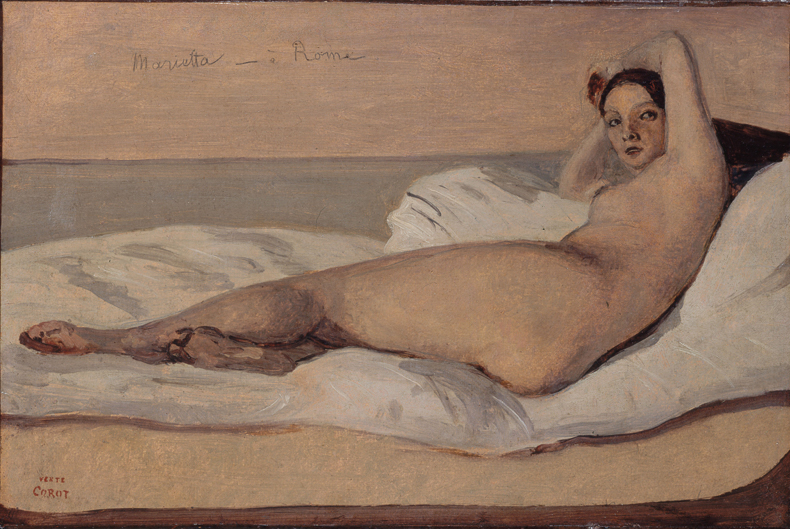William Morris said it first. Every design choice is political.
The National Gallery of Art recently unveiled its exhibit Corot: Women, a collection of 44 paintings of females—a rare gem of works by the famed French landscapist Jean-Baptiste-Camille Corot. Open through Dec. 31, the portraits run the gamut from nude to costumed, picturesque to romantic, but all beg the question: What happens when a museum invites audiences to look at paintings of women in 2018?
Corot focused on women toward the end of his lengthy career, which, as the exhibit explains, corresponded with the rise of photography and realism. These two movements contradicted the highly idealized depictions of women historically reproduced by the male gaze and brush.
Taking up the naked woman as a barometer of an artist’s skill dates centuries. But a few aspects of Corot’s style and career set him apart from his male peers. For one thing, the paintings all depict professional models—no wife or lover asked to sit for repeated portraits a la Rembrandt, Vermeer, or Picasso. Accordingly, Corot’s paintings fuse the woman and the female body, too often divorced in artistic renderings. True to personal style, Corot carries his contemplative designs, soft brushwork, muted palettes, and peaceful, harmonious silhouettes—the hallmarks of his landscapes—to the female body.
In his painting The Lady in Blue, a lone woman stands in a studio which could just as easily be a quiet corner of a cocktail party. Landscapes, presumably from Corot himself, hang on the musty wall, elevating the woman’s status to a work of art. Her cobalt confection reflects contemporary fashions of the time, and her stylized portrait follows trends led by Degas, Manet, and Monet. The woman’s jacket is removed, revealing her slightly scandalous, bare ligaments. The shadow veiling her eyes contrasts the highlights of her fleshy arm. Notably, her external presentation is colorful and vibrant and blue, but her gaze is studied and reflective, making the surroundings seem like the inner workings of her mind: gray, tinged with seafoam, compartmentalized, a little frantic, and either tortured or demure, depending on the day. Her hair is swept up in a messy bun, before this was fashionable, indicating a sense of modernity and speed as well as suggesting that this moment of calm is fleeting. This is all to illustrate that Corot’s costumed works blur the line between strict portraits and story reenactments.
Corot handles the female nude with similar care. In The Repose, Corot reimagines the iconic Great Odalisque by Jean Auguste Dominique Ingres. A nude woman reclines on a leopard print, which, along with her ethereal flower crown, makes her seem antiquated. Her pose is careful, with a blink-and-you’ll-miss-it peek of a nipple above the arm. But her face tells a different story: she is not, as the Grecian fable-like winks and bow-like lips would have you believe, a nymph or creation. She is a real woman, a model, with dark shadows under her eyes, as if juggling a newborn and a career. Her skin is uneven with purplish patches of plump, veiny skin. The bottoms of her feet look as if she has sauntered through fields of dirt and daisy. In fact, one critic commented on Corot’s rendering of real skin: “This surprises me, for there is plenty of water in Monsieur Corot’s landscapes with which to bathe.”
Like The Lady in Blue, the color scheme of The Repose is subdued. A light blue hue from the sky frames the odalisque’s head like a relief shadow or glowing halo. As the eye crawls further up the canvas, splotchy gray skies receive a similar treatment as the fleshy parts of the model’s body. Wildflowers dot the grass, and remain one of the few odes to femininity other than the painting’s heroine, the embodiment of Corot’s vision of femininity.
Importantly, Corot painted his subjects as they existed in his studio, solidifying the relationship between a male, dressed painter and real, nude woman. Corot actually encouraged his models to move and express themselves, creating a collaborative, relaxed studio environment. “It is precisely her mobility I like,” Corot said. “My endeavor is to express life. I need a model who moves.”
It seems little is lost in the translation of trees to tits. Much of the organized, thoughtful, lively beauty of Corot’s landscapes show through in the paintings, giving them a sense of modernity. The women, with their searching expressions, arrest the viewer, complicating and nuancing the politics surrounding the male gaze. Clearly Corot’s work is in direct dialogue with contemporary ideas of femininity and unavoidably, modern discussions as well.
Through the exhibit, we see Corot trying to prove himself to his critics and his peers, adopting trends from young innovators and putting his own spin on the classics. His approach to the female body is one of determined rivality; so you think I can only paint landscapes? Here are 44 delicate, reasoned, and stylized portraits of the woman to prove you otherwise. Paradoxically, this feeling of unqualification and insufficiency is familiar to most women and perhaps Corot’s truest contribution to the canon of nudes. In its modern context, the exhibit invites people of all walks to gaze. The separate rooms create many a corner for undisturbed voyeurism.
Of course, we don’t know exactly the relationship between Corot and the models or precisely how he interacted with his art’s subjects. The problematic dynamic between the male painter and the female body is inescapable due to its long, unbalanced, unequal, and predatorial history. The National Gallery has contextualized the paintings, highlighting the relationship between painter and model, and pointing out the vast valley of discordance between feminine ideals and feminine reality, a valley Corot hiked through, brush and muddy paint in hand, all the while creating a democratic space for all to gaze—with thoughtfulness, kindness, proportion, and education.





